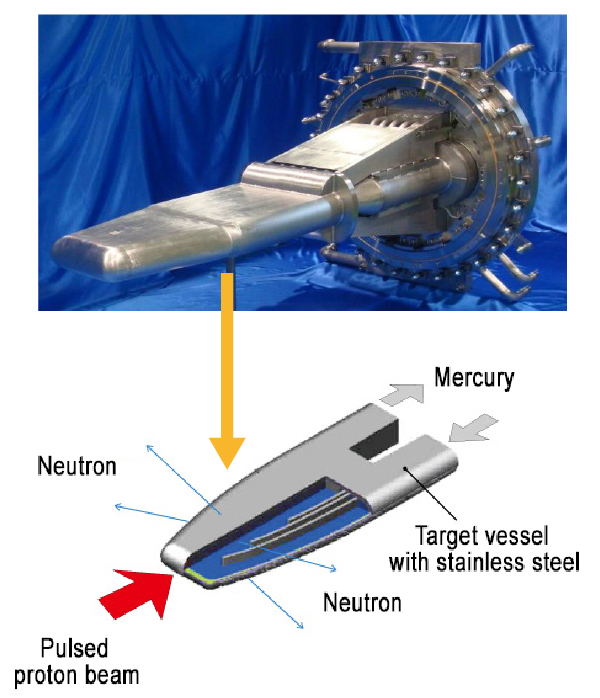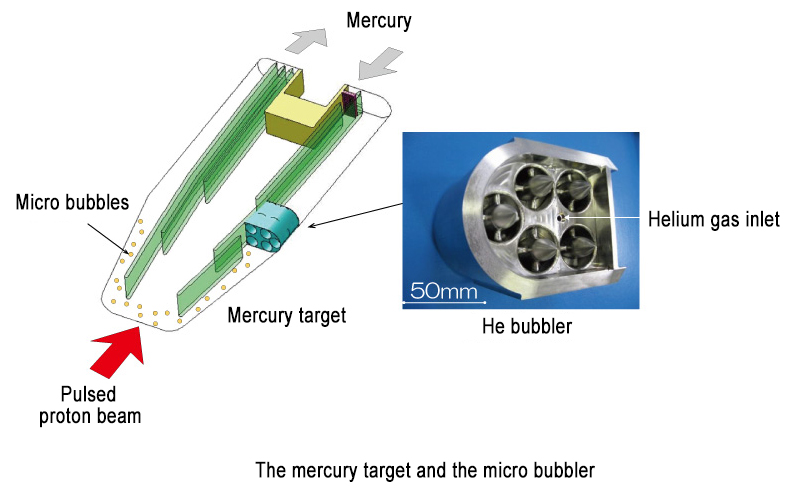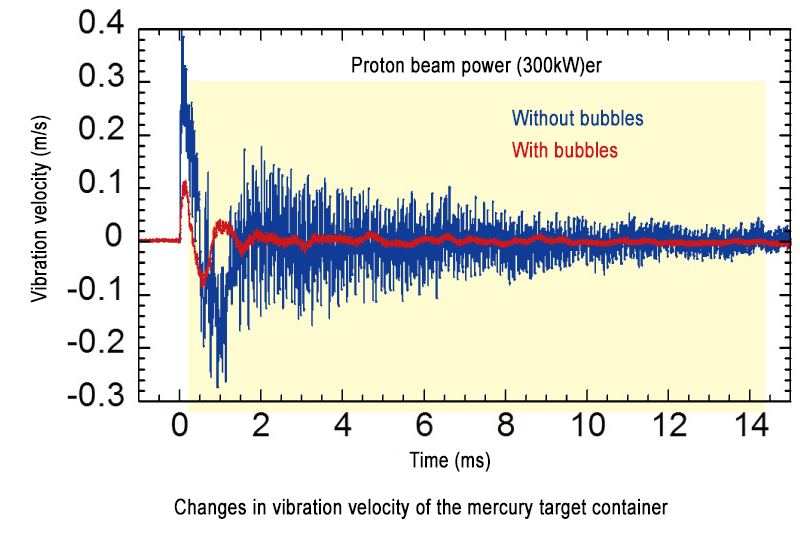Press Release
Suppressing Pressure Waves with Micro-Bubbles – The technology that helped realize the world’s most intense source of pulsed neutrons
April 23, 2013
J-PARC Center
At the Materials and Life Science Experimental Facility of J-PARC, a high-energy, high-intensity proton beam accelerated to near the speed of light is collided with a flowing, liquid mercury target 25 times every second (Figure 1). The collision induces a so-called nuclear spallation reaction in which mercury nuclei are split apart yielding high-intensity pulsed neutrons. The neutrons are captured and guided to experimental stations comprised of state-of-the-art instruments where scientists from Japan and around the world working in fundamental and applied research use them to study the structure and properties of a wide range of materials that are of interest in the materials and life sciences.
In response to the relentless demand for higher flux and the ever-increasing sophistication of experiments, facilities around the world continue to push the performance of pulsed neutron sources to new levels of power and stability.
One major technological barrier to the realization of higher power spallation neutron sources is the damage caused by high-pressure waves that are generated within the mercury vessel due to rapid thermal expansion of mercury (Figure 2). This damage – known as pitting – scales with proton beam power and can seriously limit the lifetime and reliability of the target assembly. Accordingly, R&D work aimed at suppressing, or mitigating the effect of, these pressure waves is a major research theme at facilities that currently use liquid mercury targets or propose to do so in future designs. This work is particularly important for the MLF where the design goal is to operate the facility with a proton beam power of 1 MW.
Previous off-line studies have shown that the impact force of pressure waves can be reduced using the cushioning effect of dispersed helium micro-bubbles. The technical difficulty of achieving such an effect in the MLF target is due to the very high surface tension of liquid mercury.
In response to this challenge, the MLF neutron source team developed a new type of bubbler that can instantaneously produce many micro-bubbles in mercury (Figure 3). Off-line testing of the new system was completed during spring 2012.
The performance of the micro-bubbler system installed in the actual mercury target was verified at the end of 2012 (Figure 4) and, as a result, the MLF became the first neutron facility in the world to demonstrate the effectiveness of this approach. Depending on conditions, a reduction of between 30 and 70 percent in the pressure wave impact force has been observed.
Work to improve the efficiency of the micro-bubbler system will continue as the MLF strives toward the goal of 1 MW operation.
Media Contact
Shinichi Sakamoto
Leader, Public Relations Section, J-PARC Center, Japan
TEL: +81-29-284-3587
FAX: +81-29-284-5996
E-mail: shinichi.sakamoto@j-parc.jp

Figure 1: Target vessel (top) and structure of mercury vessel inside (bottom)
Mercury is circulated at the speed of ~1 m/s continuously inside the mercury vessel. Intense pulsed proton beams hit mercury nuclei and a large number of neutrons are emitted.

Figure 2: Pressure wave generated with injection of pulsed proton beams (left) and trace of pitting damage found at off-line testing (right)
When high-power pulsed proton beams are injected into mercury they deposit a large amount of heat instantly, which causes rapid thermal expansion. This propagates as high-pressure wave at the speed of sound and place severe stress on the inner surface of the mercury vessel.

Figure 3: New design of mercury vessel with state-of-the-art helium bubbler
Many helium micro-bubbles are mixed up into mercury flow with a newly-designed helium bubbler. The micro-bubbles damp the high-pressure waves generated near the wall where pulsed proton beams are injected.

Figure 4: Effect of micro-bubbles on pressure wave suppression in actual mercury target
The vibration velocity of the target vessel correlates to the power of the pressure waves generated inside the mercury vessel. The vibration velocity was measured with the actual mercury target and it was clearly found that the vibration velocity decreased significantly and the vibration damped very quickly as well when micro-bubbles were injected. This indicates that the micro-bubbles could suppress the pressure waves very effectively.